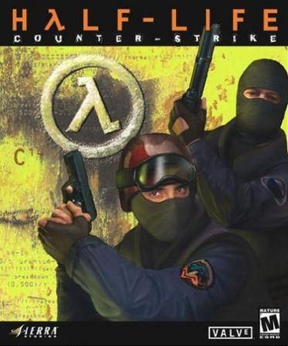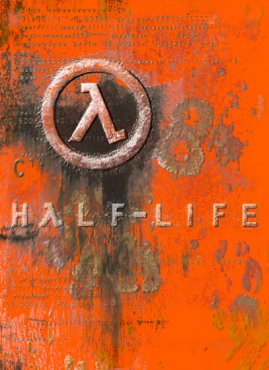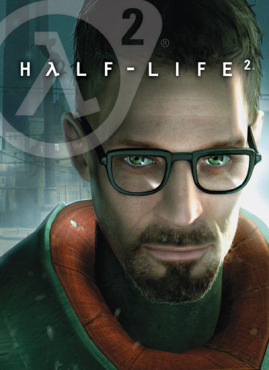
Counter-Strike is a tactical first-person shooter game developed by Valve. It was initially developed and released as a Half-Life modification by Minh "Gooseman" Le and Jess Cliffe in 1999, before Le and Cliffe were hired and the game's intellectual property acquired. Counter-Strike was released by Valve for Microsoft Windows in November 2000, and is the first installment in the Counter-Strike series. Several remakes and ports were released on Xbox, as well as OS X and Linux.

Half-Life is a 1998 first-person shooter (FPS) game developed by Valve Corporation and published by Sierra Studios for Windows. It was Valve's debut product and the first game in the Half-Life series. The player assumes the role of Gordon Freeman, a scientist who must escape the Black Mesa Research Facility after it is invaded by aliens following a disastrous scientific experiment. The gameplay consists of combat, exploration and puzzles.

Team Fortress Classic is a first-person shooter game developed by Valve and published by Sierra Studios. It was originally released in April 1999 for Windows, and is based on Team Fortress, a mod for the 1996 game Quake. The game puts two teams against each other in online multiplayer matches; each member plays as one of nine classes, each with different skills. The scenarios include capture the flag, territorial control, and escorting a "VIP" player.
Video game modding is the process of alteration by players or fans of one or more aspects of a video game, such as how it looks or behaves, and is a sub-discipline of general modding. Mods may range from small changes and tweaks to complete overhauls, and can extend the replay value and interest of the game.

Half-Life 2 is a 2004 first-person shooter (FPS) game developed and published by Valve Corporation. It was published for Windows on Valve's digital distribution service, Steam. Like the original Half-Life (1998), Half-Life 2 combines shooting, puzzles and storytelling, and adds features such as vehicles and physics-based gameplay. The player controls Gordon Freeman, who joins a resistance to liberate Earth from the alien Combine empire.

Action Half-Life is a mod for the first-person shooter video game Half-Life. It strives to simulate action movies, especially those directed by John Woo.
Source is a 3D game engine developed by Valve. It debuted as the successor to GoldSrc in 2004 with the releases of Half-Life: Source, Counter-Strike: Source, and Half-Life 2. It is most well-known for its usage by Valve, but the engine has been used both by small teams and individuals to create modifications of Valve games, and other studios creating distinct games, notably Troika Games title Vampire: The Masquerade – Bloodlines. Valve continued to create incremental updates to the Source engine after its 2004 release, most of which coincided with games created by Valve. In the late 2010s, Valve created the Source 2 engine to replace Source, with it publicly debuting alongside Half-Life: Alyx. The Source engine is most well-known for its advancements in physics, AI, and graphics.

Dystopia is a team-based, objective-driven, first-person shooter video game, developed as a total conversion modification on the Valve's proprietary Source engine. It is based on the cyberpunk literary and aesthetic genre; it is somewhat based on popular role-playing game Shadowrun, created by an amateur development team and released to the public for free. Its first playable build was released on September 9, 2005, after a year of planning and nine months of development. The first full version of Dystopia, Version 1, was released after 3 years of development on February 25, 2007.

Mod DB is a website that focuses on general video game modding. It was founded in 2002 by Scott "INtense!" Reismanis. As of September 2015, the Mod DB site has received over 604 million views, has more than 12,500 modifications registered, and has hosted more than 108 million downloads. A spin-off website, Indie DB, was launched in 2010 and focuses on indie games and news.

Half-Life is a series of first-person shooter (FPS) games created by Valve. The games combine shooting combat, puzzles and storytelling.

Garry's Mod is a 2006 sandbox game developed by Facepunch Studios and published by Valve. The base game mode of Garry's Mod has no set objectives and provides the player with a world in which to freely manipulate objects. Other game modes, notably Trouble in Terrorist Town and Prop Hunt, are created by other developers as mods and are installed separately, by means such as the Steam Workshop. Garry's Mod was created by Garry Newman as a mod for Valve's Source game engine and released in December 2004, before being expanded into a standalone release that was published by Valve in November 2006. Ports of the original Windows version for Mac OS X and Linux followed in September 2010 and June 2013, respectively. As of September 2021, Garry's Mod has sold more than 20 million copies. A successor, Sandbox, has been in development since 2015.

Jailbreak: Source is a multiplayer team-based first-person action video game, developed as a total conversion modification on the Valve's proprietary Source engine. The game was in beta development stages before it was abandoned, with its first public release on the 14th of February 2007. 0.2 followed a week later as a patch. The third major public version was released two months later on April 21, 2007. The next release was made available just over a year later, on May 3, 2008 with the latest version (0.6) being released on 15 January 2010.

Black Mesa is a 2020 first-person shooter game developed and published by Crowbar Collective. It is a third-party remake of Half-Life (1998) made in the Source game engine. Originally published as a free mod in September 2012, Black Mesa was approved for commercial release by Valve, the developers of Half-Life. The first commercial version was published as an early-access release in May 2015, followed by a full release in March 2020 for Linux and Windows.

Alien Swarm is a multiplayer top-down shooter video game developed by Valve. It is a remake of a mod for Unreal Tournament 2004, and it was developed by the original team, who were hired by Valve during the course of the development process.
Based on Id Software's open stance towards game modifications, their Quake series became a popular subject for player mods beginning with Quake in 1996. Spurred by user-created hacked content on their previous games and the company's desire to encourage the hacker ethic, Id included dedicated modification tools into Quake, including the QuakeC programming language and a level editor. As a game that popularized online first-person shooter multiplayer, early games were team- and strategy-based and led to prominent mods like Team Fortress, whose developers were later hired by Valve to create a dedicated version for the company. Id's openness and modding tools led to a "Quake movie" community, which altered gameplay data to add camera angles in post-production, a practice that became known as machinima.
Half-Life is a series of first-person shooter games created and published by Valve. Since the release of the original Half-Life for Windows in 1998, several ports, expansion packs and sequels have been canceled, including projects developed by other studios.

Research and Development is a free mod for the first-person shooter video game Half-Life 2: Episode Two. Developed by Matt Bortolino and released on July 17, 2009, it is a non-violent first-person puzzle video game, and has been compared to Portal. It received critical praise for its unique gameplay and high development quality.













